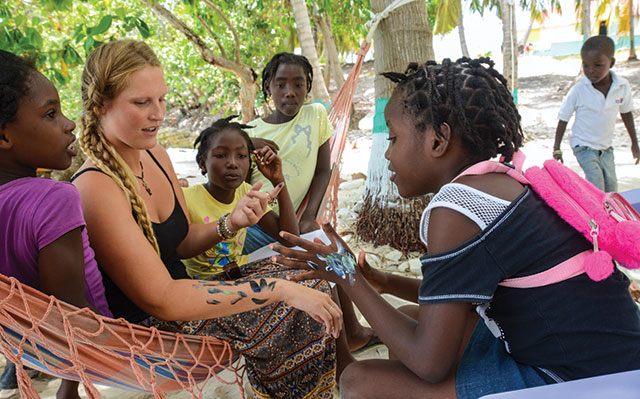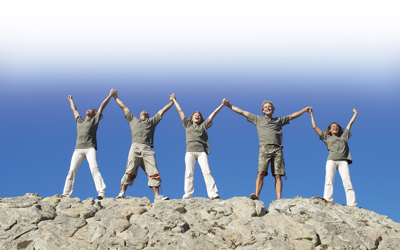Most people travel to the Caribbean to forget about work and school. But Michelle Campbell, 52, and her daughter, Cheyne, 18, spent five days during their 2014 summer holiday teaching art and English to Haitian children on the island of Île-à-Vache.
“We joined this trip so Cheyne could share her love of painting with young kids and experience a different culture,” says Michelle, a stay-at-home mom from Mooresville, N.C.
Although Michelle had volunteered abroad before — in Africa with her son a few years earlier — this was Cheyne’s first volunteer experience. “I want the kids to understand that we are all global citizens with a responsibility to each other. Volunteering is a rewarding way to reach out to others and make a difference,” she says.
Through Elevate Destinations, the Campbells worked with children, ages 4 to 12, at an outdoor summer camp. They taught basic English vocabulary — colors, numbers, songs — to their young pupils, many of whom lacked adequate food and drinking water and lived without electricity or running water. Each morning Michelle brought a pitcher of water from their hotel so the kids wouldn’t be thirsty during their lessons. Using brushes and canvases supplied by Elevate, Cheyne taught the kids how to paint colorful beachscapes.
“Their curiosity and motivation were inspiring,” Cheyne says.
The Campbells are part of a growing number of travelers interested in volunteer tourism — or “voluntourism” — in which vacationers choose to spend all or part of their downtime on altruistic endeavors. Whether they’re helping orphans in Guatemala or building a house with Habitat for Humanity, “voluntourists” have discovered the satisfaction that comes from making a positive difference at their destination.
Nowadays, there are volunteer vacations to suit everyone, regardless of age, personal interest, income, or available time. Examples range from free, short-term volunteering — like helping with kittens at a local Humane Society — to longer organized luxury travel such as Hands Up Holidays’ South African safari, which combines elephant-watching with work in a township community kitchen.
“Elevate Destinations’ cross-cultural endeavors allow both local people and volunteers to teach each other,” says program-development director Andrea Atkinson. “We don’t go to ‘save’ anyone.”
The best voluntourism trips are as rewarding for the volunteers as they are for the communities they help.
“Volunteering in a far-flung place is useful, but staying committed on an ongoing basis matters even more,” says Michelle Campbell, who has continued to raise funds since returning from Haiti. “This trip changed my daughter and me, and we’ll keep spreading the word about the people of Île-à-Vache.”
Elevate Destinations: Eleven days in Haiti, including five volunteer days and sightseeing excursions: $2,500/person. www.elevatedestinations.com
Digging for a Brighter Future
“My idea of a perfect vacation is one where I’m learning something new,” says Evelyn Ayala, 25, a veterinary assistant and history student from Prince George, Va. “I also like contributing to a worthwhile project.” She found her perfect match on a volunteer archaeology dig run by Adventures in Preservation (AiP), which works to preserve historic buildings worldwide.
On her weeklong adventure in 2014, Ayala learned how to unearth artifacts from the ruined foundation of the 1694 Fairfield Plantation in Gloucester, Va. On her first day, she uncovered a nail. “Being the first person to touch this nail in centuries blew me away.”
“Our programs wouldn’t happen without volunteers — especially projects that can’t afford paid workers,” explains Judith Broeker, AiP program director. In Virginia, the group partners with the nonprofit Fairfield Foundation, which is led by two archaeologists who rely on volunteers and college interns. Twice each summer, AiP sends 12 people to the plantation, the organization’s most popular trip.
Since 2000, volunteers have helped excavate the ruined manor house, slave quarters, and trash-disposal sites, which are rich in historic evidence. The entire project will take thousands of hours in coming years to accomplish. Meanwhile, the site’s artifacts are used to teach local schoolchildren about the county’s history.
Ayala and the other volunteers dug through layers of rubble from 9 a.m. to 4 p.m. “I wasn’t used to constant bending, and my arms ached,” she says. But piecing together the plantation’s buried past was exciting, and Ayala recognized it might lead to a better understanding of the lives of slaves who worked there — a gap in our collective knowledge of U.S. history.
“My contribution,” she says, “could make a difference for generations to come.”
Adventures in Preservation: Trips that focus on preserving historic buildings, including work in Albania, Ecuador, and Nepal. Seven-day Virginia plantation dig: $1,095/week (includes lodging, some meals, and behind-the-scenes tours of Colonial Williamsburg). www.adventuresinpreservation.org
Paying It Forward
A black-and-white dog named Patches turned nervous eyes on Valarie and Steve Niemi, who gently shampooed her in a tub at the Maui Humane Society (MHS). Relaxing under their touch, she nuzzled her head into the crook of Valarie’s arm. Patches, believed to be a pit bull terrier–cattle dog mix, was just one of a dozen dogs the Niemis bathed one afternoon during their 2013 Hawaiian getaway. But the couple, from Rancho Santa Margarita, Calif., will never forget her — or how heartwarming it felt to help shelter animals during their vacation.
“Volunteering with MHS’s Helping Paws program was way more rewarding than another afternoon at the beach,” says Valarie, 53, a billing manager. “It was our opportunity to pay it forward while enjoying a great vacation.”
The couple also donated money from their vacation fund to MHS’s Wings of Aloha program, which flies dogs to the U.S. mainland for adoption. “We wish we could volunteer more at home, but it’s hard with our schedule,” says Steve, 47, a senior vice president of sales for an electronics company.
A week after the couple returned home, MHS’s Facebook page posted photos of a freshly bathed Patches getting adopted. “We’ll never forget this vacation,” says Steve. “Next time we’re on Maui, we’ll volunteer again.”
Maui Humane Society’s Helping Paws Program: Afternoon of walking or bathing dogs, brushing cats, or playing with puppies and kittens to socialize them. www.mauihumanesociety.org
Preserving the Wilderness
Wolves yipped to each other as the early-morning sun glowed on the crags of Sheepherder Peak in southwest Montana’s Absaroka-Beartooth Wilderness. Walt -Hajducki, 64, poked his head out of his tent and breathed in the fresh, chilly air. A retiree from Woodbury, Conn., he was fulfilling a boyhood dream of discovering the wide-open West. He was also helping improve trails and eradicate invasive plant species in one of the nation’s most pristine wilderness areas.
In 2014, during two weeklong volunteer adventures into the backcountry, Hajducki tested his mettle with some firsts: hiking miles through the wilderness, sleeping outside, and wielding an ax and drawknife.
One of several projects he worked on — all organized by the Absaroka-Beartooth Wilderness Foundation and the U.S. Forest Service — involved replacing a rotted-out boardwalk across a wet meadow. Hajducki and the other volunteers tore out the old walkway, hauled heavy timbers out of the forest, and notched the timbers to level the new planks.
At the end of each workday, they fished for Yellowstone cutthroat trout, ate around the campfire, and swapped stories.
The volunteer trip held special significance: 2014 marked the 50th anniversary of the Wilderness Act.
Why drive all the way from Connecticut to Montana to do manual labor?
“At my age,” says Hajducki, “it’s satisfying to know I did my part to preserve these vast expanses of wilderness so another generation of kids can come to a place where you hear nothing but nature.”
Absaroka-Beartooth Wilderness Foundation: Summer work trips (varying lengths) focusing on trail maintenance and wildlife surveys: $75 registration fee. www.abwilderness.org
Volunteer Opportunities
Volunteer.gov
Browse opportunities by city, state, and interest through this natural- and cultural-resources volunteer portal.
Volunteer Abroad Opportunities
Search the online directory of free and low-cost volunteer positions by destination or interest in countries worldwide.
International Volunteer Programs Association
Read about member programs, including Habitat for Humanity, GlobeAware, and Cross-Cultural Solutions.|
10 Questions to Ask About Volunteer Vacations
As a growing number of commercial tour operators add volunteer programs to their itineraries, it’s important to make sure their projects truly benefit the people or places they serve — not just the travelers. As you’re planning your trip, assess how closely the tour provider follows voluntourism “best practices” (as outlined by the Planeterra Foundation and the International Ecotourism Society) by asking these questions:
- Is the project driven by local needs rather than by making travelers simply “feel good”?
- What methods does the voluntourism company use to measure a project’s achievements and benefits? Is there a regular, third-party impact assessment throughout the project?
- Are community members adequately trained so that a volunteer project continues to benefit them after volunteers have gone home?
- Where does the money go? Does part of your volunteer fee feed into the community or a nonprofit group that provides ongoing support for the project?
- Does the voluntourism organizer have the full support or buy-in of local people?
- Does the project match your interests, skills, budget, and availability? Are the accommodations and work conditions realistic for you?
- What work, specifically, will you be doing? (Mundane tasks may be more beneficial to projects than “glamorous” ones.)
- Will you be accompanied by a leader who’s familiar with the destination’s culture, language, and people?
- Is the tour operator’s mission, and how it’s achieved, clear to you? Who are the parties, nonprofits, or nongovernmental organizations (NGOs) involved?
- Is the operator willing to connect you with a participant of a past trip before you go?




This Post Has 0 Comments